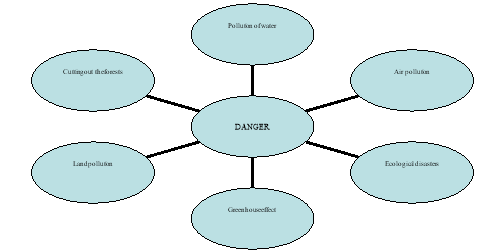Урок -конференція "Екологічні проблеми"
Цей урок допоможе вчителю покращити комунікативну компетенцію учнів, спонукатиме їх до креативного вирішення екологічних проблем.Урок допоможе учням удосконалити свої вміння та навички у всіх видах мовленнєвої діяльності, розширити свій кругозір, збагатити свій словниковий запас, проявити свої творчі та акторські здібності, реалізувати себе як цілісна особистість. Вчитель акцентує увагу на доцільному використанні інтерактивних методів і форм. Цей матеріал стане у нагоді усім вчителям англійської мови.
Урок -конференція
Тема: "Ecological problems ''
МЕТА:
- ознайомити учнів з новою лексикою та активізувати її вживання в мовленні, розширити знання учнів про проблеми екології та навколишнього середовища;
- розвивати навички читання, аудіювання й усного мовлення;
- практикувати вживання умовних речень (2 типу)
- розвивати культуру спілкування
- кмітливість та мовну здогадку;
- виховувати любов до природи, ввічливе ставлення одинe до одного.
Обладнання : підручник , ноутбук, презентація.
 ХІД УРОКУ
ХІД УРОКУ
"We won't have a society if we destroy the environment."
Margaret Mead
І. Організаційний момент (1 хв.)
Good morning, dear friends! I am glad to see you. Let’s begin our lesson.
Look at the screen. Watch the video and try to guess what we are going to discuss today.
The world we live in is really wonderful: blue oceans, seas and rivers, mountains, hills, fields and valleys. We live surrounded by this beauty.
Dear boys and girls, we are going to speak about Nature, ecological problems, how to save our planet. I think our life is very important. We live on the planet and there are a lot of people who think about the future of the planet. Some people take care of animals, others take care of birds, others are in charge of the forests. And we must be worried about nature too.The topic of our lesson is "The Earth is in Danger ''
ІІ. Підготовка до сприйняття іншомовного мовлення
Phonetic drill
Перевірка домашнього завдання
Перегляд фільму « The earth is in danger» Now let's talk about this film . What does it tell you about? Now please tell me what must we protect ? What and whom must people save ? What must we keep green ? clean ? alive ?
Power point presentation

Power point presentation
Match the words with the appropriate definition:
|
|
Fill in the gaps with new words.
1. Zakarpattya suffers ________flood.
2. Polluted water sources are______ to wildlife.
3. The Storm ___________hundreds of houses.
4. The number of damaging insect species _____ to pesticide have multiplied from 160 to 450 since 1960.
5. A third accidental deaths ______in the home.
6. After the floods, contaminated water was a serious _____ to public health.
7. Unfortunately, the_____of serious road accidents increases.
8. The drought could spell ___________for wildlife.
T. Now, pupils, let’s make the Code of Ecological Rules for all people of our town.
I think these rules should be placed all over the forest.
Power point presentation
Listening
Reading
Conference (Let’s talk)
Grammar
(Presentation) + cards
Group work
Sum up
Code of Ecological Rules.
-Don’t break trees.
-Don’t leave litter.
-Keep the country tidy.
-Respect the life and work of the countryside.
-Keep dogs under control.
-Put litter away.
-Grow trees and flowers.
-Don’t frighten birds and animals.
-Don’t cut wild flowers.
-Don’t burn fires.
T. Our lesson is coming to an end. In conclusion I’d like to tell you that the protection of nature is everybody’s business.
An outstanding English writer John Galsworthy said: «If you don’t think about the future you will not have it.” Let’s think about the future. Let’s keep our planet tidy and make it better place to live in. Let’s save the Earth for ourselves and for the next generations
We`ll finish it by reflexing our attitude to the discussed problems. I want you to choose a smile-picture of a definite colour to demonstrate your attitude to the importance of problems discussed today:
Yellow colour means that you are in a good mood and you like everything discussed today.
Green colour means your indifference to the discussed problems. Some things were interesting for you, some things not.
Violet colour means that you are in bad mood, you don`t like our lesson, you are not interested in the discussed topic.
T: Thank you.
HOMEWORK
Your marks for the lesson are… Thank you for the lesson.


про публікацію авторської розробки
Додати розробку
